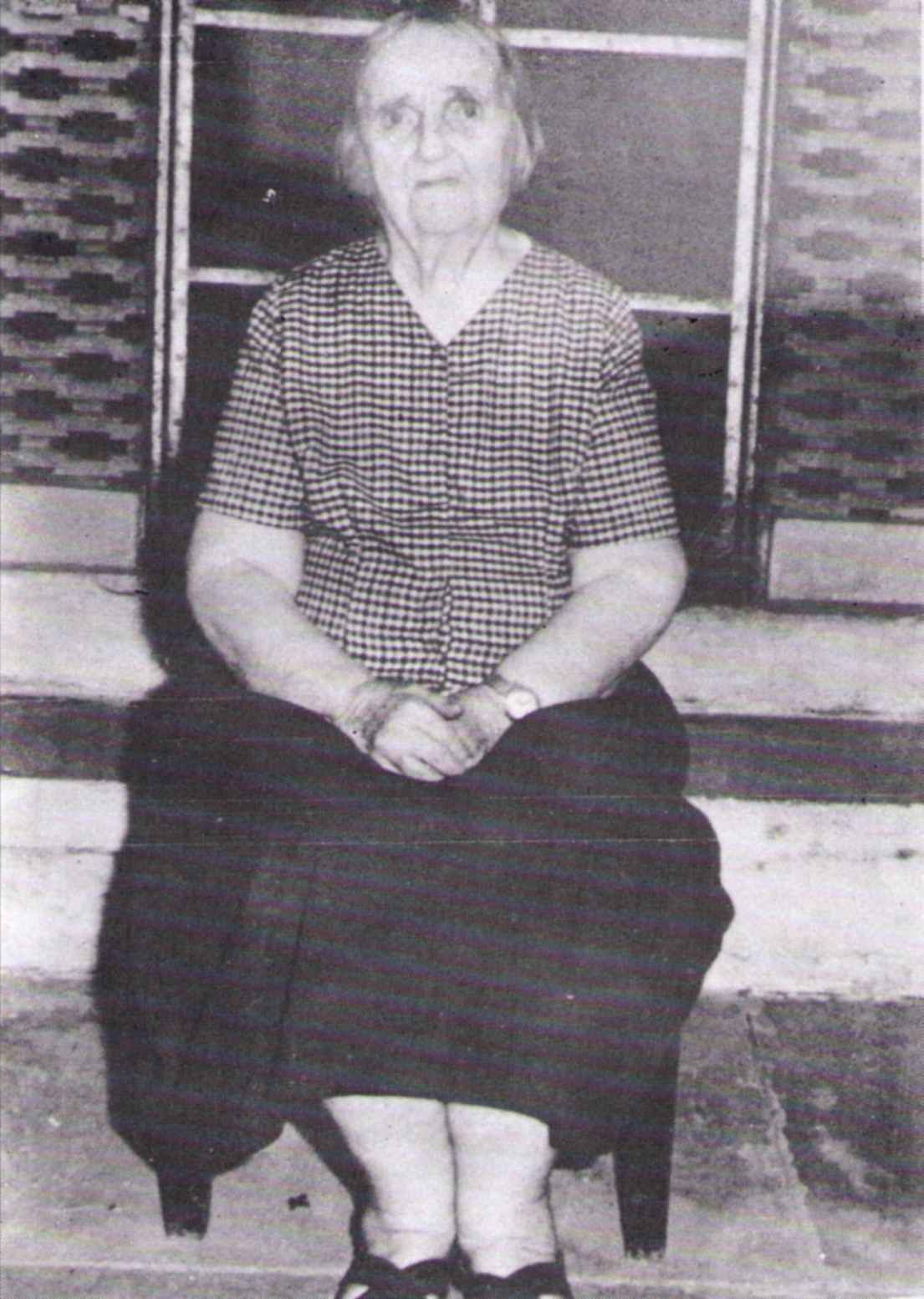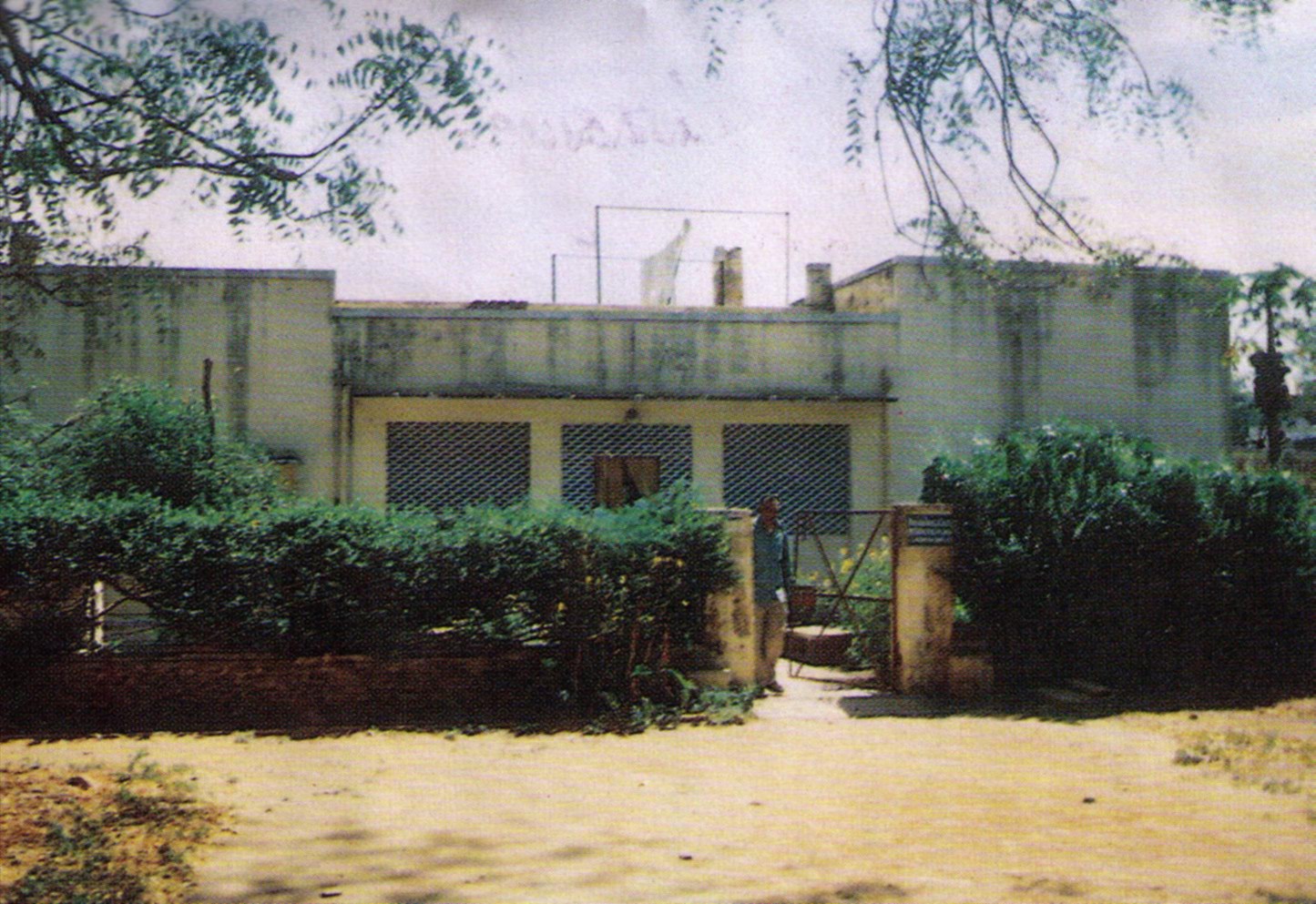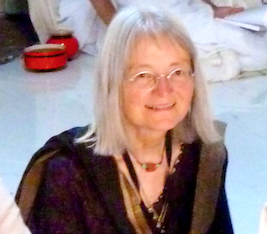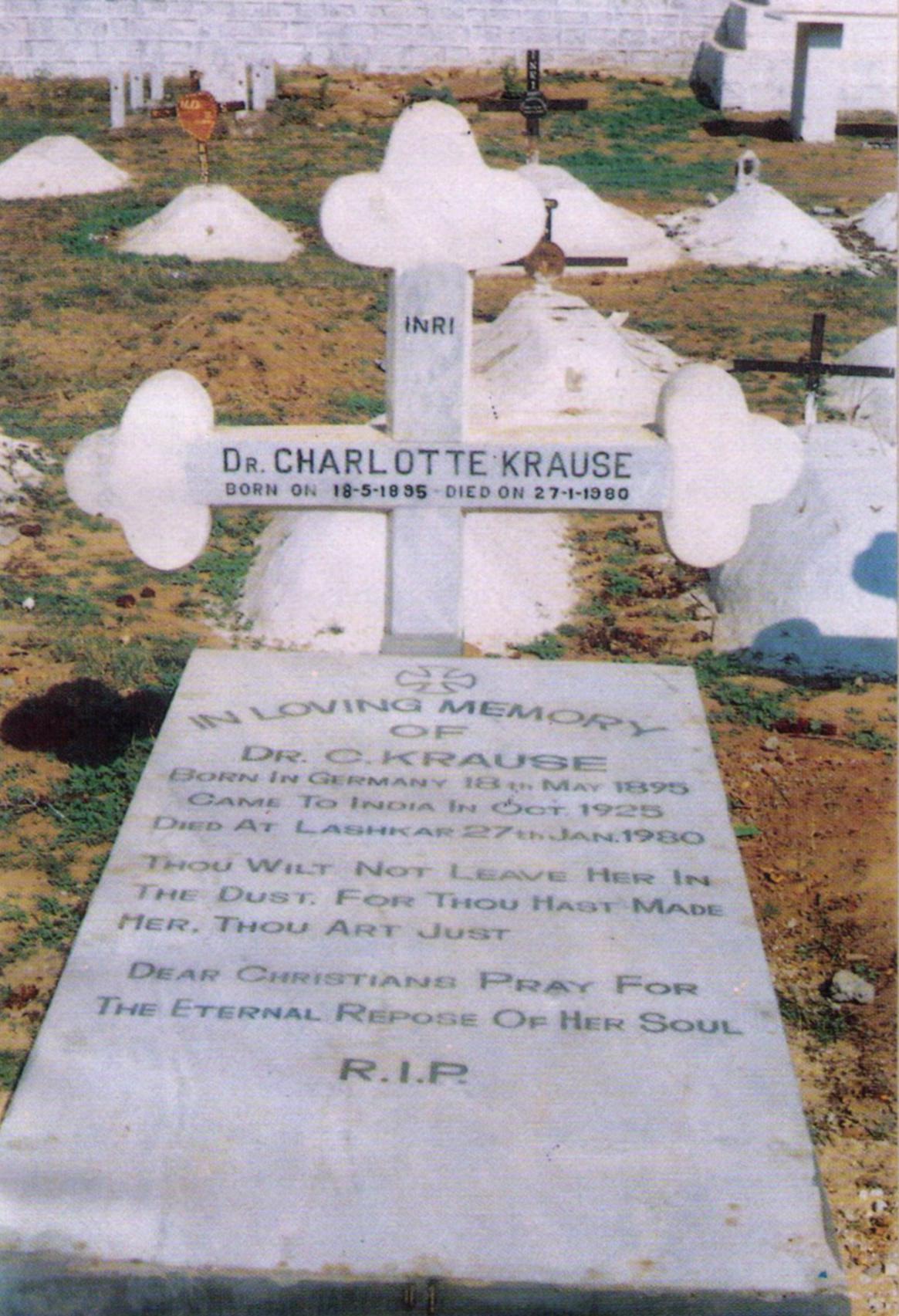The biographical essay on the German scholar Dr. (Mrs.) Charlotte Krause was published in the book German Jaina Śrāvikā Dr. Charlotte Krause. Her Life and Literature, pp. xxv-xxxvii.
German Jaina Shravika Dr. Charlotte Krause - A Biography
Dr. (Miss) Charlotte Krause's name has not been entirely unfamiliar to the academic world. She is known to both Western and Indian scholar of Indology, and especially to the Jainas. However, it will be a striking feature of human transience in all walks and endeavours, when one ventures to find out reliable data about this remarkable woman, who, apart from making a mark in Indological studies both in Germany and in India, stirs our interest in and respect for her authentic and sincere way of life.
After giving up a very promising career in German academia she spent more than half of her long life in India, doing research and working in the field of education. European and Indian scholars knew her personally, appreciated her scholarship, gained a lot from her proficiency in languages and her vast insider knowledge regarding various aspects of Jainism. Yet the memory of her fell into oblivion already during her the last years of her old age, so much so that no one took notice of her death and the usual obituary for scholars was not done. Thus, her name is missing even in such elaborate accounts as German scholars in India and the standard reference for German scholars (Kürschners Gelehrtenkalender) contains only her date of birth and her first academic works, which were published in the twenties.
Why was she so easily forgotten? Is it because she was a person, who did not thread the usual path of academicians by actually living in her field of her research, with the people concerned, i.e., the Indians, the Jaina monks, nuns and laity? Is it because she was a woman, who did not thread the usual path of women by leaving her native place, by shunning a promising career and by spending her life in research and work abroad? And is it perhaps also due to the disastrous effects and consequences of World War II, which not only immediately ruined millions of people, innumerable countries and traditions, but for many years afterwards severed all cultural communication? Many questions about motives and reasons of her curriculum vitae must unfortunately still remain unanswered. We can attempt here at least to sketch out the main lines of her biography, and especially to collect and list the available information about her scholarly work, lest it too will be lost to later students of the history of Jainism.
Charlotte Krause was born in Germany on May 18,1895 in the city of Halle on the river Saale. Her parents were Anna and Hermann Krause, a merchant and patron of the fine arts. Her three brothers were younger than she, with professions in the arts and in business. Charlotte passed her matriculation in 1914 in the then famous Girl's High School of Dessau, where she received a thorough grounding in classical as well as modern languages, in the humanities and in science. After a two year break in her education, due to the outbreak of the First World War, Charlotte Krause enrolled in the famous University of Marburg as a student of science, which had been her special interest since childhood, when she used to observe and study plants, animals and natural phenomena in the large country-estate of her maternal grandfather. It was then that she developed a deep-rooted love for nature and its creatures, by the study of which she had hoped to solve some of the great problems of life and creation.
In her studies she also had the opportunity to listen to great teachers of philosophy and history. She was immensely intrigued by these subjects and so decided finally to specialize in philosophy and religion. Hence, as was then also necessary in the curriculum, she devoted herself eagerly to linguistic studies, which is the key to the literature concerned. In several renowned German universities she subsequently studied comparative linguistics, oriental languages and especially Sanskrit with such specialists as Richard Garbe in Tübingen and Ernst Windisch and Johannes Hertel in Leipzig.
She received her Ph.D. degree as early as in 1920 in Leipzig and henceforth devoted herself to Indology, working with Johannes Hertel whose critical philological method also became the basis for her own scholarly work. She published the Jaina stories about Prince Aghata and Ambada in translation and edited the Nāsaketarī Kathā, an old Rājasthānī tale with a grammar of old Rājasthānī. This work fulfilled the requirements for the 'Habilitation', an important qualification for a career in German academia. She became a Fellow and Assistant Professor of Indian and Comparative Philology at the University of Leipzig in 1923. At the early age of 28 she was first lady fellow ever admitted there. During these years she also wrote a lengthy article on a newly discovered version of the Jaina Pancatantra in Old Gujarati.
All these works of Charlotte Krause published in Germany before she was 30 years of age. They are of a high standard, evincing not only her proficiency in philology but also her outstanding talent as a translator. She was thus able to reach out to a wider circle of readers, not only to students and scholars of religious studies and the history of literature, but also to the generally interested reader.
Johannes Hertel, the head of the Institute of Indology in Leipzig, was planning a centre for Jaina Studies at the University. He had been in lively contact with the internationally renowned scholar-monk, the Jaina Ācārya Vijayadharma Sūri and his group of sādhus, especially Acārya Vijaya Indra Sūri. The Acāryas supported Hertel's academic work by lending him numerous manuscripts, by presenting him books and also by giving him financial help for the publication of his work and the planned centre of Jaina studies. Charlotte Krause was supposed to have played a key role in this centre and therefore she was given a two year leave of absence, in order to deepen her knowledge in India itself.

Late Dr. Charlotte Krause in her house in Gwalior
On the October 15,1925 she landed in Bombay and enjoyed first the hospitality of Mr. Jamsedji Saklatwalla and his family who introduced her to Pārasī scholars, since she also intended to continue her Avesta and Pahlevi studies which she began in Germany.
In March 1926, she decided to set out on a tour of Jaina centres, invited by Mr. M. K. Shah of Bombay, the then Secretary of the Jaina Gurukula of Shivpuri. En route she visited several important Jaina places and made the acquaintance of Jaina personalities, among them Śāntamūrti Jainamuni Hamsavijaya, the poet of many a beautiful hymns in praise of the Jinas, and the scholar Mr. Keshavalal P. Modi of Ahmedabad. It was on Mt. Abu where she for the first time met the successor of the internationally renowned Jainācārya Mahātmā Vijayadharma Sūri, the equally agile protector and promoter of Jaina studies in the West, Itihāsa-tattva Mahodadhi Jainācārya Vijaya Indra Sūri. Charlotte Krause had eagerly awaited to meet him, having corresponded with him long before in the West. She also met some other learned disciples of Vijaya Dharma Sūri, Upādhyāya-Nyāyaviśārada-Nyāyatīrtha Mangalavijaya, Śāntamūrti Muni Jayantavijaya and others, whose scholarship and calmness of mind impressed her deeply.
At her destination, the Vīratattva Prakāśaka Mandala in Shivapuri, which was then in the state of Gwalior, she found an extraordinary centre of Jaina studies. During the life of the two Ācāryas the Mandala attracted both Indian and foreign scholars like a magnet. In their endeavour to promote Jainism the Acāryas were not only very open to scholars but also helpful and generous in providing books, manuscripts, discourses and information to the knowledge seekers. Among the long list of renowned scholars were those of the calibre of L. P. Tessitori, M. Winternitz, W. Schubring, L. Alsdorf to name only a few. The centre of Jaina studies in Shivapuri has now lost its scholarly vibrations entirely, it lies now almost completely abandoned, the remarkable library is unused and filled with dust. It is still under the care of the aged secretary of Vijaya Indra Sūri, who enthusiastically talks about the old, glorious days and of Charlotte Krause, whom he knew personally.
Charlotte Krause now studied and worked in this famous academic yet remote and quiet place. Very soon, and partly by teaching her fellow students English and German, she mastered Hindi and Gujarati to a degree that she herself could deliver speeches and write essays and articles in these languages. The main subjects of her studies were Old Gujarati literature, Āgamas and Jaina philosophy for which she found several erudite teachers like Śāsanadīpaka Jaina Muni Vidyāvijaya, Śāntamūrti Muni Jayanta-vijaya and Upādhyāya-Nyāyaviśārada-Nyāyatīrtha Mahgalavijaya.
She integrated well into the life-style of the monks and the nuns and travelled on foot with them through the length and breadth of India. From several sources we know that she undertook the long walk lasting more than six months from Shivapuri to Bombay together with the monks following the Ācārya and his disciples. This was one of the manifold unique experiences giving her a profound insight into the activities of such a vihāra. On the way the group visited many important Jaina places, such as Gunā, Maksi, Māndavagadha, Ujjain, Indore and Nasik. She thus came in direct contact with life in India, with its customs, dialects, various religions and sects and many Jaina communities.
During all these months she was in contact with her University in Germany and wrote lengthy letters to her teacher Johannes Hertel. A quotation from one of his letters written to her in 1927 echoes very well her accounts of this moving time: "....that the surroundings, in which you are living now attract you strongly, and that you at your youthful age [ she was 32 ] open widely your eyes, spirit and heart to all the beautiful, all that is worthy of seeing, learning and knowing, I do not only understand, but it makes me extremely happy."
In Bombay she delivered a public lecture in the Cowasji Jehangir Hall on the Correlations between Jainism and Science as well as several smaller lectures and in December 1927 she set out for a long tour to Gujarat and Kathiawar in the company of Chunilal S. Gandhi, a senior student at Shivapuri. Her tour took her to Sanjan and Navsari with their ancient Pārasī civilisation, Baroda, Ahmedabad, Viramgam, Mandal, Sankeshvar with its famous shrine of Lord Pārśva, Vadhvan, Sayla, Limbdi, Bhavnagar, where she met Mr. A. G. Sunavala and the learned Seth Kunvaraji Anandji, Talaja with its beautiful Jaina temples, Mahuva, the birth place of Vijayadharma Sūri, Junagadh, Girnar, Veraval, Prabhas Patan, Porbander, where she was the guest of Devidas Gherveria, the well-known patron of Jaina studies, Jamnagar, Dvaraka, Rajkot.
During a stay in Beawar on this trip Charlotte Krause publicly announced that she is taking the vow of ahimsā and was henceforth known as Subhadra Devi. Her leave from the University of Leipzig was extended for two more years. She returned to Shivapuri in April 1928 and continued her studies and thus gaining a deep insight in the various branches of Jainism. Her learning won her great approval everywhere in India and on the occasion of the anniversary of the Shivapuri institution in Autumn 1928 she was honoured with the title Bhāratīya-Sāhitya-Viśārada in the presence of numerous erudite representatives of the Jaina community and members of the ruling council of the Gwalior state.
In December of the same year Charlotte Krause's father came to India and both of them set out for a sight-seeing tour of North and Central India, during which time they also had a chance to meet several Jaina communities and Jaina ascetics, like Munirāja Lalitavijaya in Sadri.

Charlotte Krause's house in Lashkar, Gwalior.
After seeing her father off in Bombay, Charlotte Krause went straight back to Shivapuri in February 1929. It must have been at this time that Charlotte Krause resolved not to return to Germany, fully aware of the consequences. Most important among these was the loss of her post in the university in Leipzig, because it could no longer be retained for her and so her academic career in Germany came to an end. For her, the stay in India at that time was a most profitable and receptive period of learning, followed by a productive period of lecturing and publishing. Her publications during this time are less the result of special indological research, than the reflections of an experienced and committed western observer. They are critical and prove a very sound and differentiated judgement. In her article The Social Atmosphere of Present Jainism (1929) she analyses the nuisance of caste-practices by the Jainas in North and Central India and the conflicts between Śvetāmbaras and Digambaras over the claim on Tīrthas. Other examples of her publishing activity from this time are An Interpretation of Jaina Ethics (1929) and Individual and Society (1931).
In the year 1932, after seven years of intensive life and work in Shivapuri, Charlotte Krause left the community and went to Gwalior. She became the tutor of Princess Kamalā Rājā, the sister of the then Rājā of Gwalior and afterwards she served as the Deputy-Inspector General of Female Education in the Gwalior State.
During World War II she was not interned like other German nationals but was allowed to remain free due to the protection of Rājā Jivājī Rao Scindia of Gwalior who granted her sanctuary in the Scindia Oriental Institute in Ujjain, where she held the post of a curator from 1942 to 1947. During these years she published several works in English, Hindi and Gujarati. Her indological publications concentrate on two major areas: one pertaining to hagiographical research, viz., Jaina Sāhitya Aur Mahākāla Mandira (1944) and Siddhasena Divākara and Vikramāditya (1948). The other encompasses critical editions of hymns and didactic poems (sajjhāya) of the Jainas. The texts are in Sanskrit, Apabhramśa and Old-Gujarati. The editions are partially furnished with extensive comments and notes. These works appear as five articles in the Jaina Satya Prakāśa (1945-1954) and in the books Trana Prācīna Gujarātī Krtio (1951) and Ancient Jaina Hymns (1952).
After 1952 Charlotte Krause settled again in Gwalior, now as Indian citizen. She received a small pension from her occupation as Inspectress of Schools and gave private lessons in English and German. Apparently she did not publish much anymore and might have lost contact with the established academia in the West. Some of her German and Indian scholar-colleagues have observed that because she failed in her attempts to get a research assignment in India, such as from the L. D. Institute of Indology in Ahmedabad, she might have felt that she was not really recognised by the scholarly world. One even wonders whether this was the reason why she did not participate in the All India Oriental Conference in Ahmedabad in 1953.
In about 1960, she came in contact with the Catholic Church in Gwalior and started taking interest in the Catholic faith. Soon afterwards she converted to the Roman Catholic faith. In 1962, she had a small house built in the premises of the Catholic Church St. Johan the Baptist in Gwalior on the agreement that the bungalow would belong to the Church after her death. She stayed there until her death on January 27,1980.
Scholarly Bequest (seen by Luitgard Soni in March 1996) in Bhandarkar Oriental Research Institute (B.O.R.I.), Pune:
In her will Dr. Charlotte Krause wrote: "To the Bhandarkar Oriental Research Institute (B.O.R I.), P. O. Deccan Gymkhana, Poona-1,I leave (1) all my books other than on Homoeopathy and Medicines, (2) my finished and unfinished research papers and notes with their boxes, if any."
According to the librarian at B.O.R.I. around 1635 titles were received in 1981. The books are not yet catalogued but they are in the register of books received. The 'finished and unfinished research papers and notes' are kept in a room in the first floor of the B.O.R.I. library together with papers, correspondence and bequests of other scholars. The bequest Krause is kept in six bundels containing the following:
- Boxes:
- One box of cards recording the botanical names in the Svetāmbara Canon.
- One box recording the Pārśva Tīrthas mentioned only in texts already printed.
- Manuscripts:
- Lecture for the 'Habilitation' 16-6-1923: "Die Entwicklung der arisch-indischen Sprachen." (The Development of the Indo-Aryan Languages).
- Gujarati Grammar for teaching in the University 1923/24.
- Sanskrit for Beginners.
- Introductory remarks about the interpretation of Prākrt-texts.
- On the Brhatkathā.
- 'Die indo-arischen Sprachen' (The Indo-Arian Languages), 33 pages, typed with hand-corrections.
- Notes referring to Dharmadeśanā of Vijayadharma Sūri (This is the title of a series of papers published by Vijayadharma Sūri in the Journal Jaina-Śāsana).
- Śri Śukanadīpikācupau (in Gujarati, 21 pages, handwritten).
- Sūryamatī, Queen of Kashmir (Manuscript of a lecture about Sūryamatī, according to Kalhana's Rājatarahginī, handwritten).
- Note-books (in German, Prākrt):
- Literature concerning Pratyākhyāna.
- Various studies on Pratyākhyāna (especially on food).
- Studies and translations concerning Pratyākhyāna from the Canon of the Śvetāmbara.
- Three note-books on Pratyākhyāna, also according to the Abhidhāna Rājendra Kośa.
- Preliminary Works on Botany (e.g., Prajnāpanā).
- Sūtrakrtānga.
- Botany according to Varnaka.
- Miscellaneous.
- Prajnāpanā (Survey).
- Other Note-books:
- Eleven note-books of various contents: collections of verses, lexicography in Gujarati regarding the language used by Śvetāmbara Sādhus of different gacchas (e. g., terms for clothing or utensils).
- Notes for Charlotte Krause's own lectures.
- Notes on sermons given by Vidyāvijayajl.
- Copy-books:
- On Vijaya Indra Sūri in Gujarati.
- Śrī Mallinātha Rasa (two books).
- Notes on the Nayas.
- Old Gujarati Rasa: Aitihāsika Rasa Sahgraha I-III (English Translation).
- Aitihāsika Rasa Sangraha IV: Darśanavijaya, Vijaya Tilaka Sura Rasa, Shivapuri 1921 (English translation).
- Translation of Sūrīśvara ane Samrāta.
- Copies of various manuscripts, dated February 1943, Ujjain.
- Notes on astrological studies.
- Translation of the Vetāla-panca-vimśatikā from the Gujarati (ed. by Jagjivanadasa Dayalji Modi) dated 1921.
- Several copy-books with copies of manuscripts from the Scindia Oriental Institute, Ujjain.
- Unpublished Articles:
- Wie man in Gujarat kocht and speist (How one cooks and eats in Gujarat).
- Indische Kultur (Indian Culture).
- Mathurā: Das indische Jerusalem (Mathura: The Indian Jerusalem).
- Pracīna Rūpa men Ahimsā Pratipādana.
- Der Jaina Tempel (The Jaina Temple).
- The Jaina Story of Aghata, The Source of an Ancient German Tale.
- The Mallinātha Rasa by Rsabhadāsa, dated 14-7-1934.
- Von indischen Wassern (About Indian Waters).
- A Jaina Monk (About Vidyāvijayajī).
- Newspaper-articles in Jayaji Pratap, Gwalior:
- Shivapuri or the Śāntiniketana of the Jainas, January 1930.
- Rohinī, September 1934.
- Fire Divine, October 1937.
- English in Female Education, June 1942.
- The Birth of a Royal Child in Ancient India, March 1942
- Grhastha-jīvana kī ridha grha udyoga hain, April 1947.
- Other Newspaper Articles:
- My Gurus, Newspaper-article in the Divali issue of The Hindustan, 1927, p. 27.
- Jaina Utsavom kī Viśesatā, Śrī Vehkateśvara Samācāra, October 1928.
Bibliography:
1922 1924 1925 1925 1926 1928 1929 1929 1930 1930 1930 1930 1930 1931 1932 1933 1934 1944 1945 1945 1946 1946 1948 1951 1952 1954 1955 1955 n.d. n.d.
Dr. Charlotte Krause's Graveyard in Gwalior
 Dr. Luitgard Soni
Dr. Luitgard Soni
